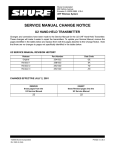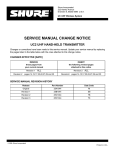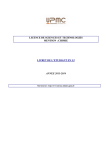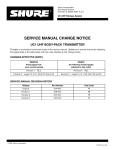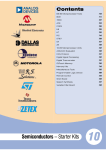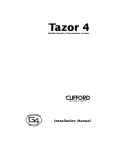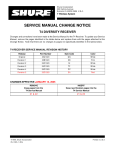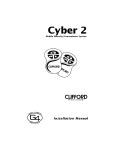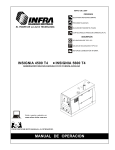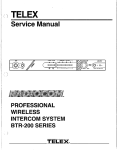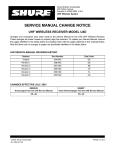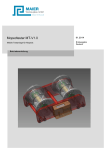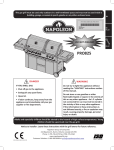Download SERVICE MANUAL CHANGE NOTICE
Transcript
Shure Incorporated 222 Hartrey Avenue Evanston IL 60202-3696 U.S.A. UHF Wireless System SERVICE MANUAL CHANGE NOTICE U1/U1L UHF BODY-PACK TRANSMITTER Changes and corrections have been made to the Service Manual for the U1/U1L UHF Body-Pack Transmitter. These changes will make it easier to repair the transmitters. To update your Service Manual, remove the pages identified in the tables below and replace them with the pages attached to this Change Notice. Note that there are no changes to pages not specifically identified in the tables below. U1/U1L SERVICE MANUAL REVISION HISTORY Release Part Number Date Code Original 25A1021 QE Revision 1 25B1021 SA Revision 2 25C1021 TD Revision 3 25C1021 AG Revision 4 25C1021 BF Revision 5 25C1021 BG CHANGES EFFECTIVE JULY 12, 2002 REMOVE these pages from the U1/U1L Service Manual 21 to 25 E 2000, Shure Incorporated 25–1021–2 (BG) INSERT these Revised pages into the U1/U1L Service Manual 21 to 25 Printed in U.S.A. Service Manual U1/U1L Body-Pack UHF Transmitter General Characteristics The Shure U1/U1L Body-Pack UHF Transmitter is a microprocessorcontrolled body-pack transmitter operating in the UHF frequency range. This product is intended for use in high-end installed sound, rental, and concert sound applications. Different frequency variations are available. Controls and Indicators 1 3 4 5 NOTE: All models shipped after February 1999 have a soldered attached antenna to replace the screw-on removable antenna. . 1 2 7 8 O O N FF 9 6 10 11 12 1. Antenna 2. Programmable Display 3. Input Connector (U1L uses LEMO connectors) 4. ON/OFF Switch 5. On/Off LED 6. Belt Clip 7. MODE Button 13 8. 9. 10. 11. 12. 13. SET Button Audio Gain Control Battery Cover Release Tabs Battery Compartment Cover Battery Fuel Gauge Battery Compartment Figure 1. U1/UL Transmitter Controls and Indicators Service Note: Shure recommends that all service procedures be performed by a Factory-Authorized Service Center or that the product be returned directly to Shure Brothers Inc. Licensing: Operation may require a user license. Frequency or power-output modifications may violate this product’s approvals. Contact your country’s communications authorities. E 1999, Shure Incorporated 25B1021 (BG) Printed in U.S.A. Shure U1/U1L Body-Pack UHF Transmitter Circuit Description Audio Section Audio enters L201, an inductor that is used as an rf choke. The signal enters a 6 dB pad made up of R203, R204, C204, and C206. The signal is ac-coupled through C205 into a 40 dB (30 dB for JB frequencies) user-adjustable gain stage around U201A. This gain stage is externally accessible to the user. C201, C202, and C207 protect the pre-amplifier and bias circuits from rf interference. R205 and R207 set up a half-supply bias, and R206 sets the ac input impedance. The amplified audio signal is then passed through a pre-emphasis network before entering the compression stage. R208, R211, and C211 set up two corners for the pre-emphasis network. The pre-emphasis network boosts the high frequencies before transmission and helps set the hinge point (0 dB gain) of the compandor. The network feeds NE575 compandor U203, which utilizes an external amplifier U202B. The compandor performs 2:1 logarithmic compression of the audio signal. Transistors Q201 and Q202, along with crystal Y202, form the tone key oscillator circuit, which provides a stable, continuous 32.768 kHz sine wave. Transistor Q204 buffers the tone key signal before it is added to the audio signal. The tone key signal is used in the receiver to provide audio output only when the tone key signal is present in the transmitted signal. Therefore, if the tone key or the transmitter is turned off, the receiver will be muted. Q203 acts as a switch for toggling the tone key on and off. It is controlled via the microprocessor. R224 allows the tone key amplitude level to be set. The tone key circuit is powered by U208B, which is a dc amplifier that multiplies the 3 V battery voltage to 4.5 V (gain = 1.5). As the battery voltage drops, the tone key supply voltage also drops, which decreases oscillator amplitude. The tone key amplitude is used by the receiver to indicate transmitter battery strength. The tone key feature indicates battery level at the receiver. It is not available on JB models. The tone key signal, along with the processed audio signal, is fed to summing amplifier U202A. Resistors R232 and R233 set up a half-supply bias. Resistor R231, located at the output of the summing amplifier, prevents spurious oscillations from the operational amplifier. After passing through ac-coupling capacitor C232, the signal is fed to the rf module. Circuit Description 2 25C1021 (BG) Shure U1/U1L Body-Pack UHF Transmitter Rf Section Processed audio enters R243, an internal potentiometer adjusted for 45 kHz deviation (100% modulation) with a –7.2 dBV, 1 kHz tone, at the output of the front audio stage (pin 1 of U201). On JB models, R243 is adjusted for 5 kHz deviation with –63.2 dBV, 1 kHz tone, at the input to the transmitter. The audio is then fed to the tuning voltage pin of the voltage controlled oscillator (VCO) and modulates the carrier directly. The use of a phase locked-loop (PLL) frequency synthesized system eliminates the need for multiplier stages, resulting in a much higher degree of spectral purity. The VCO is shielded against interference from external rf fields. Regulated +5 Vdc power from the dc-to-dc converter ensures frequency stability, even if the battery voltage changes. At the output of VCO U205, the rf signal splits into two paths. The output of the VCO is coupled by C244 to the frequency control pin of synthesizer U204. The synthesizer’s internal circuitry divides the signal as necessary to reach the desired reference frequency. The synthesizer contains a quartz-controlled reference oscillator circuit, including a 4.0 MHz crystal (Y201), that is adjusted by means of trimmer capacitor C239. The transmitter output frequency is user-selectable. Frequency selection is made via microprocessor U103, which interfaces with the user by means of the mode/select switches. The output of the synthesizer is a series of pulses that are integrated by a passive loop filter (R238, C245, R240, C266, C267, R239, and C247) to produce a control voltage signal. The control voltage signal is then connected to the VCO through amplifier U210A, which is used to isolate the PLL filter from the audio modulation signals. The VCO output is also coupled to an rf power amplifier through a resistive pad consisting of R254, R255, R256, R257, and an LC matching network containing C261, L209, and C248. The rf power amplifier, dual gate MESFET Q208, is fixed-tuned and configured as a common source device. Amplifier stability is obtained through resistive loading on the input, R247. The output of Q208 contains a low-pass matching network (L206) and an LC-type low-pass filter (LP206), which provide a high degree of spectral purity. The output of the low-pass filter feeds a microwave isolator that reduces the production of reverse third-order intermodulation products. The transmitter is capable of delivering a maximum of +10 dBm (10 mW) to the 50 Ω antenna. During transmitter power-up and frequency selection, rf power is muted by bringing the base of Q209 high. This provides approximately 45 dB rf attenuation until the PLL has locked. The transmitter rf is then unmuted by bringing the base of Q209 low. During transmitter power off conditions, voltage is first removed from the VCO by bringing the base of Q207 high. In this way, the transmitter carrier signal is not allowed to drift off frequency during power on or power off conditions. 25C1021 (BG) 3 Circuit Description Shure U1/U1L Body-Pack UHF Transmitter Transmitter Display Board The display board consists of the following circuitry blocks. Microcontroller Section The microcontroller section consists of microcontroller U103 and the liquid crystal display (LCD). The microcontroller has an on-board liquid crystal display (LCD) driver. R111, R113, and R114 supply the microcontroller with the LCD drive voltage for a four-plex drive. The LCD indicates the UHF frequency group and channel. The LCD also has a battery fuel gauge. A 4.000 MHz oscillator, Y101, provides the operating frequency to the microcontroller. The oscillator circuit includes C107, C108, R102, and R103, which along with Y101, U106, R112, and C112, form the reset circuit. U106 is the reset integrated circuit (IC) that resets the U103 microcontroller if the 5 V normal operating voltage falls below 3.5 V. R107 is the pull-up resistor for the U103 programming voltage pin. Memory Section The memory section consists of U101, a non-volatile EEPRAM, that stores current transmitter settings and the mapping of compatible groups and channels. Battery Management Section The battery management section consists of comparator U102. It is used to measure the effective battery voltage, with reference to +5 V, by measuring the time used to charge a capacitor to a reference threshold of 0.1 Vdc ± 0.01 Vdc. The battery is checked approximately every 5 seconds. Comparator U102 alternately charges C106 with +5 V reference voltage, then the battery voltage (PLUS signal, test point I109). User Interface Section The user interface section consists of the Power, Mode, and Set switches. The status of each switch function is indicated on the LCD. Power Supply Section The U105 dc-to-dc converter provides the transmitter with regulated +5 V derived from two AA batteries. Power MOSFET Q101 provides reverse battery protection. Q103, R118, R286, and C124 control the soft start and reset of dc-to-dc converter following battery voltage drops. Circuit Description 4 25C1021 (BG) Shure U1/U1L Body-Pack UHF Transmitter Preliminary Tests Test Component Locations ABCD MC68H * *Shorted with a 0 Ω resistor on F board versions and later. Digital Display Board, Side 1 Digital Display Board, Side 2 * *On F board versions and later. *On F board versions and later. * * Rf-Audio Board, Side 2 Rf-Audio Board, Side 1 Mic-Jack Board, LEMO 4-Pin, Mic-Jack Board, TINI Q-G 4-Pin, Figure 2. Test Component Locations 25C1021 (BG) 5 Preliminary Tests Shure U1/U1L Body-Pack UHF Transmitter Listening Test Before completely disassembling the transmitter, operate it to determine whether it is functioning normally and try to duplicate the reported malfunction. Refer to the User Guide for operating instructions, troubleshooting, and specifications. Review any customer complaint or request, and focus the listening test on any reported problem. The following, more extensive, functional tests require partial disassembly. Functional Tests Refer to the Disassembly section to partially disassemble the transmitter for the following functional tests. Use dc blocks at all rf outputs to protect test equipment. Test Setup 1. Use a U4 receiver for the following functional tests. 2. Dc voltages are present at most rf test points. Use dc blocks to protect the test equipment, if necessary. 3. Connect the (+) power supply terminal through a milliammeter to the (+) contact on the battery nest, and the (–) power supply terminal to (–) the contact on the battery nest. 4. Connect a dc voltmeter across the power supply and set the power supply for +3 Vdc.. 5. Connect the audio generator to the mic-jack board either via the TINI QG connector, or the LEMO connector to BNC cable, depending on mic style. Rf Power 1. Attach a U4 antenna to the spectrum analyzer. 2. Turn the U1 on and hold it very close to the antenna. Move the U1 up and down to maximize power on the spectrum analyzer. 3. Verify that output power is greater than 3 dBm. Current Drain 1. Apply 3.0 Vdc to the battery terminals. 2. Verify that the current drain is less than 110 mA. Preliminary Tests 6 25C1021 (BG) Shure U1/U1L Body-Pack UHF Transmitter Frequency Response If the U1 has an attenuator switch on the back of the unit, it should be set to –6 dB for the following tests (versions G or later). Values between board versions may vary slightly; the following values are typical values. 1. With the transmitter set to minimum gain, apply 200 mVrms at 1 kHz to its input. 2. Connect the audio analyzer’s input to the unbalanced output of the U4 receiver. 3. Make sure the receiver volume control is set to maximum. 4. With respect to the 1 kHz level, measure –8.22 dBu ± 2 dB. 5. Change the frequency to 100 Hz. Verify that the measurement from the U4 unbalanced output is within ± 2 dB with respect to the 1 kHz level. 6. Change the frequency to 10 kHz. Verify that the measurement from the U4 unbalanced output is within ± 2 dB with respect to the 1 kHz level. 25C1021 (BG) 7 Preliminary Tests Shure U1/U1L Body-Pack UHF Transmitter Notes This page intentionally left blank. Notes 8 25C1021 (BG) Shure U1/U1L Body-Pack UHF Transmitter Disassembly and Assembly ATTENTION Observe precautions when handling this static-sensitive device. Disassembly NOTE: All models shipped after February 1999 have a soldered attached antenna to replace the screw-on removable antenna. Do not try to remove and replace the soldered attached antennas. 1. 2. 3. 4. Open the battery compartment cover and remove the batteries. Remove the belt clip. Remove the two screws from the back of the case. Lift the top half of the transmitter case away to expose the printed circuit boards. 5. Remove the two screws securing the battery nest to the chassis. 6. Remove the rf ground screw, located next to the antenna. 7. Lift the printed circuit boards out of the case. TOP COVER RF SHIELDING GASKET BATTERY NEST DIGITAL DISPLAY CIRCUIT BOARD RF GROUND SCREW RF-AUDIO CIRCUIT BOARD ANTENNA BATTERY COMPARTMENT COVER CONDUCTIVE WASHER (SLIPS OVER ANTENNA) NOTE: All models shipped after February 1999 have a soldered attached antenna to replace the screw-on removable antenna. . BELT CLIP Figure 3. U1/U1L Hand-Held Transmitter Disassembly 25C1021 (BG) 9 Disassembly and Assembly Shure U1/U1L Body-Pack UHF Transmitter Reassembly After completing all repairs, replace the antenna. Then place the circuit boards back in the case, making sure the multi-pin connectors on the boards mate. Reassemble the transmitter by performing the steps of the disassembly procedure in reverse order. Disassembly and Assembly 10 25C1021 (BG) Shure U1/U1L Body-Pack UHF Transmitter Service Procedures Service Notes Units With Date Codes Earlier Than August 1996 A small number of synthesizer ICs (U204) can experience start-up problems with the 4 MHz crystal reference oscillator. The problem will only occur for certain values of tuning capacitance. The transmitter displays the correct group and channel information. However, the carrier will have moved to its lowest possible frequency (around 750 MHz). The tuning voltage of the VCO will read 0 Vdc. Adjusting the crystal’s tuning capacitor to its lowest value should cause the 4 MHz crystal oscillator to start up, and the carrier will lock to the proper frequency. The tuning capacitor can now be readjusted to center the carrier to within ± 1000 kHz. However, once the unit is turned off, the problem may return. All units with August 1996 date codes or later have a 10 kΩ resistor from pin 2 of the synthesizer to ground to insure that the internal oscillator will start up for all values of tuning capacitance (C239). Safe values for the resistor are from 16.8 to 33.2 kΩ. Product Changes Antenna Changes All models shipped after February 1999 have a soldered attached antenna (70A8017) to replace screw-on removable antenna. Attenuator Switch SW201 Attenuator switch SW201 has been added to the audio section of the rf-audio printed circuit board. All products shipped after February 1997 (board versions “F” and later) should include this switch. Inductor L104 Removal Inductor L104 has been removed for improved electrostatic discharge (ESD) performance. On products shipped after March 1997, L104 was replaced with a jumper. On “F” and later versions of the board, the circuit was redesigned and the jumper was removed. Shure recommends that any product shipped before March 1997 have L104 removed and replaced with a jumper. Comparator U102 Comparator U102 has been changed to prevent an “88 88” display. 25C1021 (BG) 11 Service Procedures Shure U1/U1L Body-Pack UHF Transmitter Antenna Replacement NOTE: All models shipped after February 1999 have a soldered attached antenna to replace the screw-on removable antenna. Do not try to remove and replace the soldered attached antennas. The top printed circuit board (pcb) is connected to the bottom pcb by a multi-pin connector. Two wires also lead to the battery connector and a three-wire flat cable that connects the pcbs to the microphone jack. Handle the pcbs with care to avoid damaging these connections. 1. Open the battery compartment cover and remove the batteries. 2. Remove the belt clip. 3. Remove the two screws from the back of the case. 4. Lift the top half of the transmitter case away to expose the pcbs. 5. Remove the single screw visible next to the antenna connector. 6. Use the antenna to gently lift up both pcbs far enough so that the antenna assembly clears the case, or remove the top pcb to gain better access to the bottom pcb. 7. Remove the antenna by unscrewing it from the connector. Make sure that the washer on the antenna clears the case. 8. Install the new antenna by screwing it onto the connector. If necessary, replace the conductive rubber gasket at the base of the antenna. 9. Return the pcbs to their original position. 10. Reinstall the single screw next to the antenna connector. 11. Perform these steps in reverse order to reassemble the unit. Service Procedures 12 25C1021 (BG) Shure U1/U1L Body-Pack UHF Transmitter Measurement Reference dBu is a measure of voltage, and dBm is a measure of power. For example, the HP8903 should be labeled dBu instead of dBm because it is a voltage measurement. These two terms are often used interchangeably even though they have different meanings. Audio levels in dBu are marked as dBm on the HP8903. dB Conversion Chart 0 dBV = 2.2 dBu 0 dBu = 0 dBm, assuming the load = 600 Ω Test Equipment Most test equipment needed is described in the Shure Wireless Service Equipment Manual. The following test equipment (or approved equivalent) is also needed. Table 1 Test Equipment Equipment Type Model Audio analyzer *Hewlett-Packard 8903B Digital multimeter Fluke 87 Interconnect Cable Shure PT1843 BNC (Male) Cables (2) Shure PT1838A DC Blocker Shure PT1838W BNC (Female) to 1/4-inch Phone Plug Adapter Shure PT1838C 20 dB Attenuator Shure PT1838T BNC to QG Cable Shure PT1825 BNC to LEMO Cable Shure PT1878 BNC (Female) to SMC (Female) Adapter Shure PT1838S BNC (Female) to SMC (Female) Adapter Shure PT1838S Test Cable, Japan Version Shure PT1838–AF Adapter, Japan Version Shure PT1838–AJ BNC (Male) to RG–174 Cable, unterminated Shure PT1824 Frequency counter Hewlett-Packard 53181A Rf signal generator Hewlett-Packard 8656B Spectrum analyzer Hewlett-Packard 8590L Shure U4S receiver Shure U4S *Audio levels in dBu are marked as dBm on the HP8903B. Printed Circuit Board Interconnecting Cable This cable is provided with the standard test equipment and is used to connect U1 circuit boards that have been removed from the case for servicing. It is made from two custom Shure printed circuit boards, a fourinch, 11-wire ribbon cable, and one male (Shure 170A07) and one female (Shure 170A08) surface-mount connector. Note that the SMC connectors face in opposite directions. Female SMC connector Male SMC connector (on back side) Figure 4. Printed Circuit Board Interconnecting Cable 25C1021 (BG) 13 Service Procedures Shure U1/U1L Body-Pack UHF Transmitter Rf Alignment FREQUENCY COUNTER CH 2 CH 1 J3 U1 Transmitter Frequency Counter Power (S103): ON Connect CH2: J3 Gain (R201): For JB models: set to maximum Figure 5. Alignment Test Set–Up Rf Alignment Set-Up 1. Proper adaptors should be used to connect the test equipment. 2. Use RG58 or other low-loss 50 Ω cables for all rf connections. 3. Include the insertion loss of the cables and connectors in rf conductive power measurements. 4. Connect the rf–audio board to the digital board through board interconnects J104 and J200. 5. On all models except JB, audio GAIN potentiometer R201 does not need to be preset to any position. On JB models, R201 GAIN should be set to maximum. 6. All rf measurements should be made from the antenna output connection, the 50Ω SMC connector on PCB versions “G” and earlier or through the P1824 test cable on PCB versions “H” and later. For JB models with SMT rf test connector, use PT1838–AF with PT1838–AJ. Rf Alignment 1. Slide the ON/OFF switch (S103) to the ON position. 2. Connect the transmitter to the frequency counter via J3. 3. Determine the transmitter operating frequency by comparing the Group and Channel information on the LCD to the tables in the User Guide and User’s Guide Supplements. 4. Adjust variable capacitor C239 until the frequency counter measurement matches the desired operating frequency, ±1 kHz. Service Procedures 14 25C1021 (BG) Shure U1/U1L Body-Pack UHF Transmitter Power Output Measurement The output power measurement ensures that the output signal is strong enough for sufficient range when the system is in use. The output power measurement also verifies that the output power is not above the specified maximum level, to ensure compliance with regulatory agencies’ standards. SPECTRUM ANALYZER U1 Transmitter Spectrum Analyzer Power: ON Peak search: ON Signal track: ON Marker: ON Figure 6. U1 Power Output Measurement Test Set-Up 1. Rf output power is not adjustable. Use RG58 or any other low loss 50 Ω cables for all rf connections. 2. Include the insertion loss of the cables and connectors in rf conductive power measurements. 3. Using the spectrum analyzer, verify output power is at least +8 dBm. JB models must be at least +8 dBm and cannot exceed +10 dBm. 25C1021 (BG) 15 Service Procedures Shure U1/U1L Body-Pack UHF Transmitter Audio Alignment Deviation Reference Voltage NOTE: DC VOLTAGES ARE PRESENT AT MOST RF TEST POINTS. USE A DC BLOCK ON THE RF SIGNAL GENERATOR TO PROTECT TEST EQUIPMENT. S201 TONE-KEY SWITCH U4 RECEIVER DC BLOCK AUDIO ANALYZER RF SIGNAL GENERATOR U4 Receiver Audio Analyzer Output: Unbalanced Gain: Maximum Squelch: Mid Tone Key (S201): OFF Measurement: AC level Filters: Low-Pass (30 kHz): ON Rf Signal Generator INT: FM INT: 1 kHz Output Amplitude: –50 dBm High-Pass (400 Hz): ON Figure 7. Deviation Reference Voltage Test Set-Up, Using a U4 Receiver 1. The U1 transmitter should be turned OFF for this procedure. 2. Connect the rf signal generator to antenna A or B on a U4 receiver. Make sure the dc block is on the rf signal generator. 3. Set the rf signal generator to the same frequency as the U1 transmitter. 4. Set rf signal generator modulation to 1 kHz and set the deviation to 45 kHz for UA, UB, MA, MB, MC, and MD models, 40 kHz for KK models, and 5 kHz for II models. 5. Set the output amplitude of the rf signal generator to –50 dBm. 6. Turn the U4 receiver ON and set the tone key switch (S201) inside the U4 receiver to the OFF position. This will disable the receiver tone key function. 7. Connect the audio analyzer to the unbalanced output of the U4 receiver. The voltage should be 4.2 ± 0.5 dBu (1.26 ± 0.07 V) for UA, MA, MB, MC, MD, and KK models, and –26.2 ± 0.5 dBu for II models. Note the voltage obtained; it is the deviation reference voltage. 8. Disconnect the rf signal generator from the U4 receiver and return the tone key switch (S201) to the ON position. Service Procedures 16 25C1021 (BG) Shure U1/U1L Body-Pack UHF Transmitter Deviation Reference Voltage Adjustment U4 RECEIVER 20 dB PAD DC BLOCK AUDIO ANALYZER NOTE: DC VOLTAGES ARE PRESENT AT MOST RF TEST POINTS. USE A DC BLOCK ON THE RF SIGNAL GENERATOR TO PROTECT TEST EQUIPMENT. U1 Transmitter Power: +3 Vdc Audio Analyzer Measurement: AC level Gain: Minimum; for JB models, set to MAX Output: 1 kHz Filters: Low-Pass (30 kHz): ON High-Pass (400 Hz): ON Figure 8. Deviation Reference Voltage Adjustment Test Set-Up 1. The U1 transmitter should be turned ON for this procedure. 2. Turn the rf signal generator OFF for this procedure. 3. For G and later board versions, adjust the audio analyzer for 1 kHz to get a level of –5.0 dBu (436 mV) at pin 7 of U201. 4. For F or earlier board versions, adjust the audio analyzer for 1 kHz to get a level of –5.0 dBu (436 mV) at pin 1 of U201. 5. On JB models, adjust the audio analyzer for 1 kHz to –61.0 dBu at the input connector. 6. Connect the transmitter rf output to a U4 antenna connector through a dc block and a 20 dB pad. 7. Connect the U4 unbalanced output to the audio analyzer’s input. 8. Adjust R243 until the audio analyzer reads the deviation reference voltage, measured in the last test, from the unbalanced output of the U4 receiver, ± 0.1 dB. 9. Turn OFF the 30 kHz low-pass filter and the 400 Hz high-pass filter on the audio analyzer. 10. Disconnect the audio analyzer output from the U1 mic input. 25C1021 (BG) 17 Service Procedures Shure U1/U1L Body-Pack UHF Transmitter Tone Key Level Adjustment AUDIO ANALYZER U1 Transmitter Power: +2.5 Vdc Audio Analyzer Measurement: AC level Gain: Minimum; for JB models, set to MAX Output: None Filters: Low-Pass (30 kHz): OFF High-Pass (400 Hz): OFF Figure 9. Tone Key Level Adjustment Test Set-Up 1. Use a dc power supply to apply 2.5 ± 0.01 V to the battery terminals, with no audio applied to the audio input. 2. Make sure no filters are used on the measuring instrument. 3. The tone key frequency will be approximately 32.768 kHz. Adjust R224 so that the tone key level of –22.8 ± 0.1 dBu (56 mV) is measured at U202, pin 1. For JB models, this level should be –24.7 dBu ± 0.1 dBu (45 mV). Service Procedures 18 25C1021 (BG) Shure U1/U1L Body-Pack UHF Transmitter Bench Checks Dc Problems nMeasure the dc voltage at pin 1 of C104. This is the output of the dc to dc converter. It should be 5V ± 0.2 Vdc. nMeasure the dc voltage at C113, pin 1, and C105, pin 1. It should be 5V ± 0.2 V. nVerify the battery voltage is between 2 V and 3.5 V. nCheck for proper Vcc and +5 V rf at Q207 (make all dc measurements with respect to rf ground unless otherwise specified). If incorrect voltage is present, check the values of the biasing resistors. nTrace the dc back to the dc to dc converter. nCheck the power switch. nLook for open coils, cracked parts, reversed polarity capacitors, solder shorts. If there is a short to ground from 5 V, isolate different parts of the circuit. nVerify rf OFF signal changes from +5 V at power on/power off to 0 V during normal operation. Trace the signal to the microprocessor. Q207 should be saturated during normal operation. nVerify that the battery voltage appears at U105 pin 1. nVerify that the Vds (drain to source voltage) of Q101 is approximately –0.025 V. Q101 should be saturated. nVerify that the dc to dc converter output is 5 V at pin 8 on U105. Rf Problems nIf the carrier is out of specification by less than 40 kHz and cannot be corrected by adjusting C239, check the values of C239, C238, and Y201. If these values are correct, replace Y201. As a last resort, replace synthesizer U204. nIf the carrier frequency is not within the allocated UHF bandwidth, or if it is unstable, the loop is unlocked. Check the solder connections at the head board, VCO, microprocessor (traces LE, D, and CK), and synthesizer U204. nCheck for 4 MHz frequency at pins 1 and 2 of U204. If frequency other than 4 MHz is detected, replace crystal Y201. nCheck the loop filter: R238, C245, R240, C266, C267, R239, C247 U208, R243, and R285. nCheck U204, pins 3 and 4, and U208, pin 8. nReplace synthesizer U204. The tuning voltage of the VCO should be approximately 3 Vdc when the transmitter is programmed for the center of the frequency range. 25C1021 (BG) 19 Bench Checks Shure U1/U1L Body-Pack UHF Transmitter Low Rf Output Power nCheck the VCO power output. If the power output is still low, the VCO is faulty. nVerify power across C261. Isolate the rest of the circuit by removing L209. nCheck R254, R255, R256, R257, C261, L209, and C248. nVerify the dc bias of Q208. Verify that the rf mute signal changes from +5 V at power on/off to 0 V during normal operation. If Q209 is not saturated during normal operation, rf power at the antenna will be attenuated by approximately 45 dB. nIsolate components, starting from the antenna and working back to the rf power amplifier. nCheck continuity from U207, pin 1, to the center conductor of J3. nRemove microwave isolator U207 and check the low-pass filter power output at LP201, pin 4. It should be approximately 10 dBm. nRemove the low-pass filter and check the power output of the amplifier at LP206, pin 1. nCheck the output matching network: Q208 C258, L206, and C256. nCheck the bypass capacitors: C254, C253, C252, and C5. nReplace Q208. nReinstall L209 and U207. nCheck continuity between pins 1 and 4 of LP201. Excessive Current Drain nIsolate different sections of the circuit (rf, audio, digital, dc to dc converter). nApply +3 V to the battery terminals and measure the current drain, using a dc milliammeter. It should be less than 110 mA. Deviation Problems nIf R243 cannot be adjusted to obtain 45 kHz deviation, isolate the problem to either the audio or rf section. nCheck R243. nCheck the rf section by setting the transmitter frequency to 800 MHz and verifying that the tuning voltage of the VCO is approximately 3 Vdc. Bench Checks 20 25C1021 (BG) Shure U1/U1L Body-Pack UHF Transmitter Replacement Parts and Drawings Model Variations Different frequency versions of the U1 and U1L transmitters are currently available for use in various countries. Each version is identified in the table below by country code, frequency range, and printed circuit board version. **Some frequency versions have been discontinued. For the new list of frequency variations use the MK2 manual. Table 2 U1/U1L Model Variations COUNTRY CODE FREQUENCY RANGE COUNTRY DESIGNATION UA 782–806 MHz U.S.A. and Canada 90UA8739J 90UA8740M MA 782–810 MHz Germany 90MA8739M *90MA8740M* (No Longer Available) (No Longer Available) *90JB8739J* – JB 806–810 MHz Japan U1 RF-AUDIO PC BOARD NUMBER U1L RF-AUDIO PC BOARD NUMBER (No Longer Available) KK 838–862 MHz MB 800–830 MHz MC 774–782 MHz 90KK8739M – Europe 90MB8739J – Netherlands 90MC8739J – To create an MD board, order the 90MB8739J PCB’s and install the MD EEPROM . MD UB United Kingdom 692–716 MHz U.S.A. 90UB8739M 90UB8740M **For PCB’s that are no longer available use the U1–MK2 manual for replacements. Parts Designations The following comments apply to the parts list and the schematic: Resistors: Unless otherwise noted, all resistors are surface-mount with 1/10 W rating and 1% tolerance. Capacitors: Unless otherwise noted, non-polarized capacitors are surface-mount NPO dielectric types with a 100 V capacity and a 5% tolerance, and polarized capacitors are tantalum types. 25C1021 (BG) 21 Replacement Parts and Drawings Shure U1/U1L Body-Pack UHF Transmitter Table 3 U1/U1L Transmitter Replacement Parts Reference Designation A1 Description Shure Part Number Belt clip assembly 90A4392 MP1 Antenna (removable); units shipped before 2/99 95A8731 MP2 Antenna (soldered); units shipped after 2/99 70A8019 MP3 Battery nest 95A8751 MP4 Battery nest screw MP5 Bushing MP6 Case back 32A8034A MP7 Case door 32A8025A MP8 Case top 32A8021A MP9 Coil spring 44A8012 MP10 Conductive gasket 80C8198 MP11 Door spring 65A8243 MP12 Foam pad 36A675 MP13 Hinge pin 31A8142 MP14 Lens 65A8236 MP15 LCD (liquid crystal display) 95A8934 MP16 Nameplate 39B8227 MP17 Nameplate battery 39_8411 MP19 Retainer plate 53A8419 MP20 EMI Washer for use with 95A8731 antenna only 36B8066 Replacement Parts and Drawings 30K8136A 66A308 22 25C1021 (BG) Shure U1/U1L Body-Pack UHF Transmitter Table 4 Printed Circuit Board Replacement Parts: Side 1 Reference Designation Description Shure Part Number Non-SMT Components MP21 J101,102 R201 S101,102 Y202 Mic PCB Ribbon Cable 95A8622 Socket strip 56G8069 Potentiometer, 0.1 W, 20%, 100 k 46C8049 Switch, pushbutton, SPST 55A187 Crystal, 32.768 kHz 40A8010 SMT Components C239 Capacitor, trim, 7 / 50 pF 152H02 J200 Header, 11 Position 170A07 Inductor 15%, 33 µH 162B16 L101,102,103 L104 Resistor 1/8 W, 5%, 0 145AJ000 L201,203 Inductor 10%, 0.18 µH 162R10 L202 Ferrite bead 162A03 L206 Inductor 10%, 0.12 µH 162A10 LP206 Filter, low pass 162A17 Q101 Transistor, MOS FET, MDT3055EL 183A35 Q201 Transistor, NPN SOT-23, MMBT5089L 183A38 Q203 Transistor, PNP SOT-23, MMBT5087 183A01 R208 Resistor, 1/10 W, 1–5, 249 R224, 243 25C1021 (BG) 145BF2490 Trimming pot, 1/4 W, 25%, 1 k 146B02 U104 Diode, switching, 7000L 184A08 U201,202 Integrated Circuit, 33178 188A18 U203 Compander, integrated circuit, NE575 188A126 U204 PLL Frequency Synthesizer 188A134 Y101 Crystal, 4 MHz, for Microcontroller 140A005 Y201 Crystal, 4 MHz, for U204 140A09 23 Replacement Parts and Drawings Shure U1/U1L Body-Pack UHF Transmitter Table 5 Printed Circuit Board Replacement Parts: Side 2 Reference Designation Description Shure Part Number Non-SMT Components D102 LED, green 86C8419 Receptacle, TINI QG, 4-pin, male: U1 ONLY 95A8413 J103 Receptacle, LEMO, OS: U1L ONLY 95A8601 S103 Switch, toggle, DPDT 55A189 J2 SMT Components D101,103 Rectifier, Schottky, MBRS140 184A16 D201,202 Diode, dual 184A08 J104 Receptacle 170A08 Inductor 10%, 0.18 µH 162R10 Transistor, MOS FET, MDT3055EL 183A35 Transistor, NPN SOT-23, MMBT5089L 183A38 Transistor, PNP SOT-23, MMBT5087 183A01 Transistor, Dual Gate Ga As MESFET, NE25139 183C12 Switch, 3-position 155A09 U102 Comparator 188A136 U105 Integrated Circuit, 5 V dc/dc converter, MAX751CSA 188A182 U106 Voltage detector 188B210 U208 Dual operational amplifier 188A118 L200,205,208, 211 Q102 Q103,202,204 Q207,209 Q208 SW201 *Variations in part numbers correspond to country codes. Table 6 U101 EPROM Table Replacement Parts and Drawings Country Code Shure Part Number UA 188T131UA UB 188T131UB MA 188T131MA MB 188T131MB MC 188T131MC MD 188T131MD JB 188T131JB KK 188T131KK 24 25C1021 (BG) Shure U1/U1L Body-Pack UHF Transmitter Table 7 VCO Selection Country Code UA205 VCO Range Shure Part Number UA 782–810 MHz 187A10R KK 837–863 MHz 187B10R MB 800–830 MHz 187C10R 692–716 MHz 187D10R MA MC JB MD UB Table 8 Microwave Isolator Selection UA207 Country Code Shure Part Number UA 187A07 MA MB MC MD JB 25C1021 (BG) KK 187B07 UB 187C07 25 Replacement Parts and Drawings Shure U1/U1L Body-Pack UHF Transmitter This page intentionally left blank. Replacement Parts and Drawings 26 25C1021 (BG) Shure U1/U1L Body-Pack UHF Transmitter A BCD * MC68H SIDE 1 *Shorted with 0 Ω resistor. SIDE 2 U1 / U1L Body-Pack Transmitter Digital Display Board Legends and Foils “E” and Earlier Board Versions 25C1021 (BG) 27 Replacement Parts and Drawings Shure U1/U1L Body-Pack UHF Transmitter U1 / U1L Body-Pack Transmitter Digital Display Board Legends and Foils “F” and Later Board Versions Replacement Parts and Drawings 28 25C1021 (BG) Shure U1/U1L Body-Pack UHF Transmitter SIDE 1 SIDE 2 U1/U1L Body-Pack Transmitter RF–Audio Printed Circuit Board Legends “E” and Earlier Board Versions 25C1021 (BG) 29 Replacement Parts and Drawings Shure U1/U1L Body-Pack UHF Transmitter SIDE 1 SIDE 2 U1/U1L Body-Pack Transmitter Rf–Audio Printed Circuit Board Legends “G” and Later Board Versions Replacement Parts and Drawings 30 25C1021 (BG) Shure U1/U1L Body-Pack UHF Transmitter LEMO, 4-Pin TINI QG, 4-Pin Mic-Jack Printed Circuit Board Legends and Foils 25C1021 (BG) 31 Replacement Parts and Drawings Shure U1/U1L Body-Pack UHF Transmitter Notes This page intentionally left blank. Replacement Parts and Drawings 32 25C1021 (BG)


































